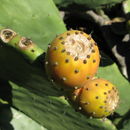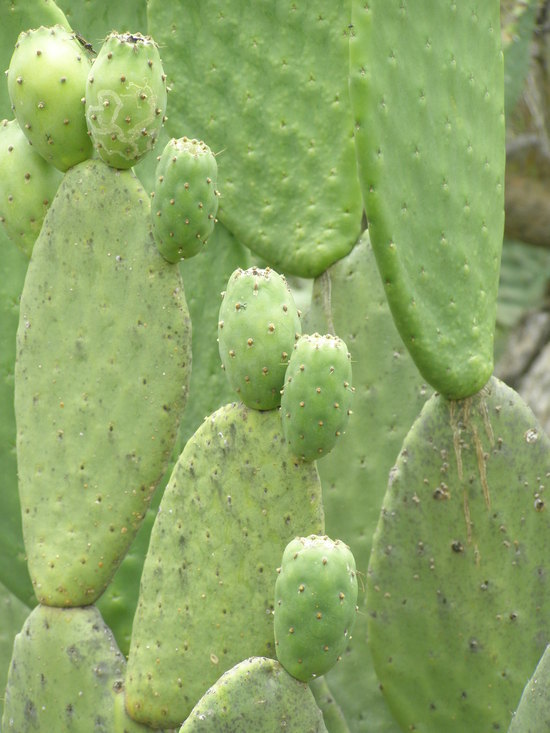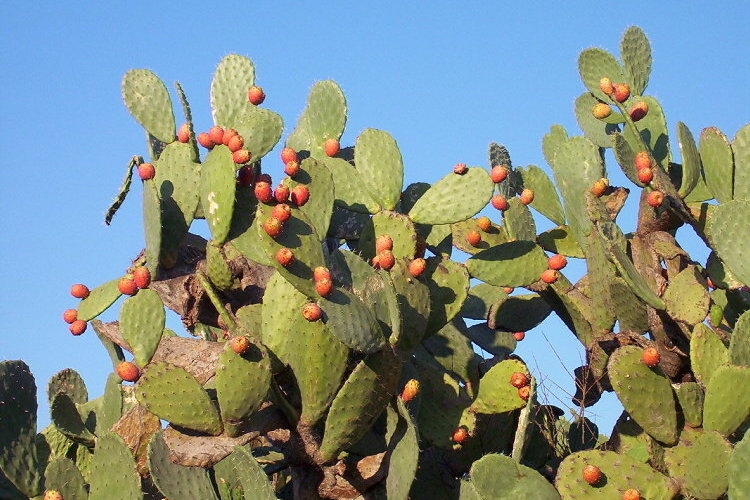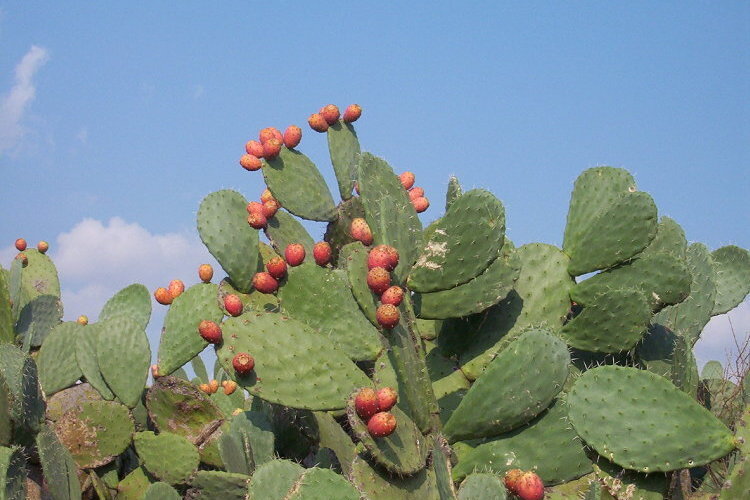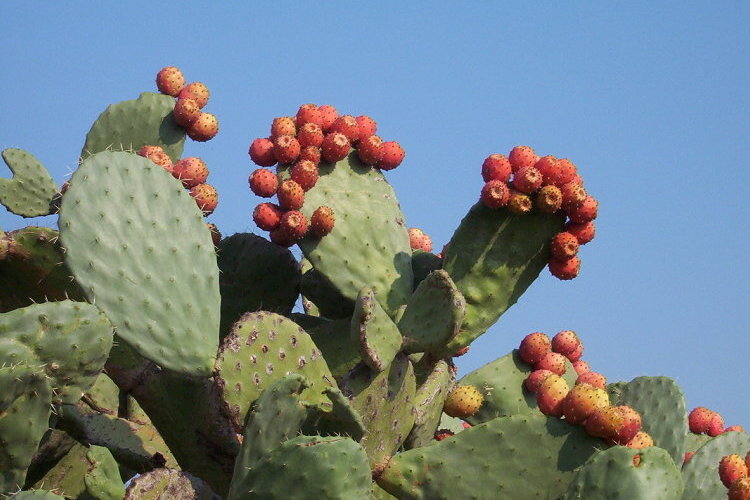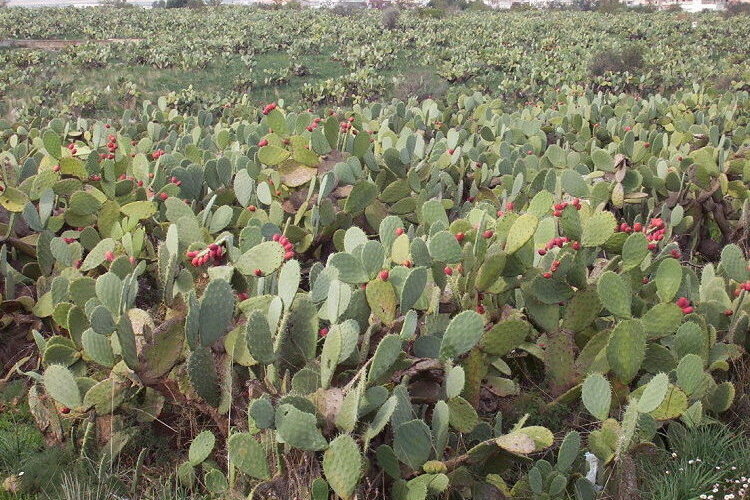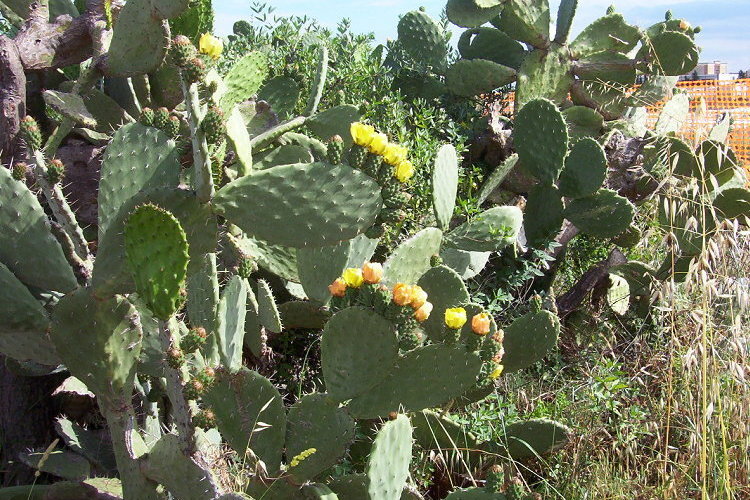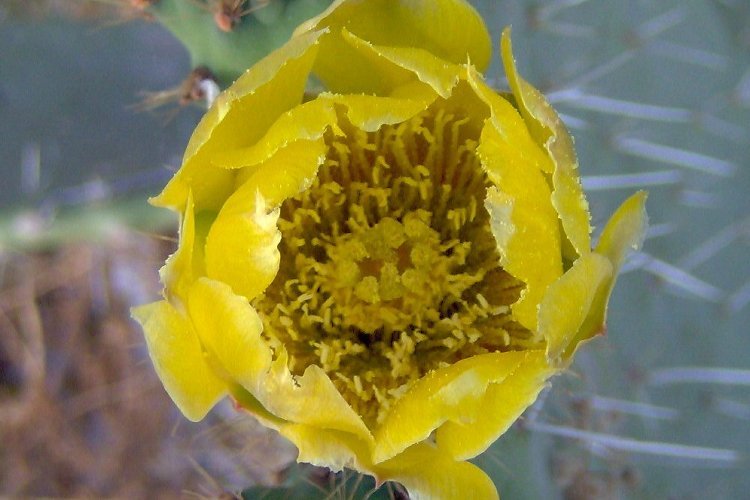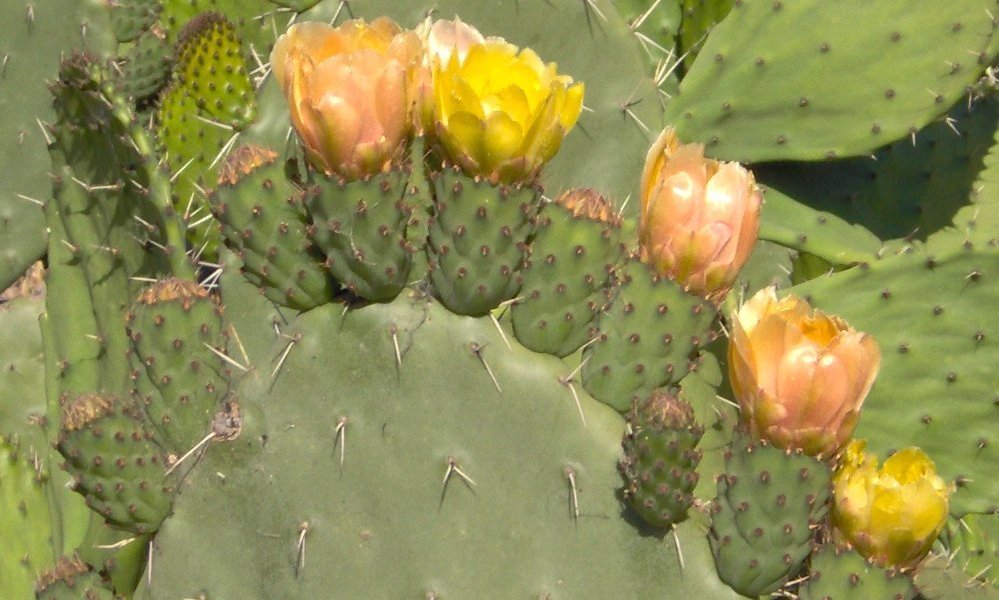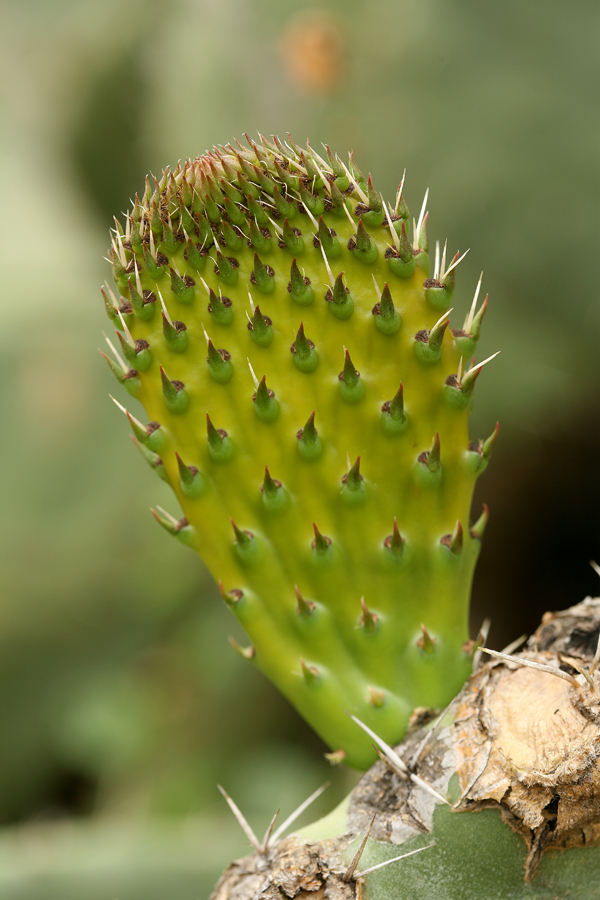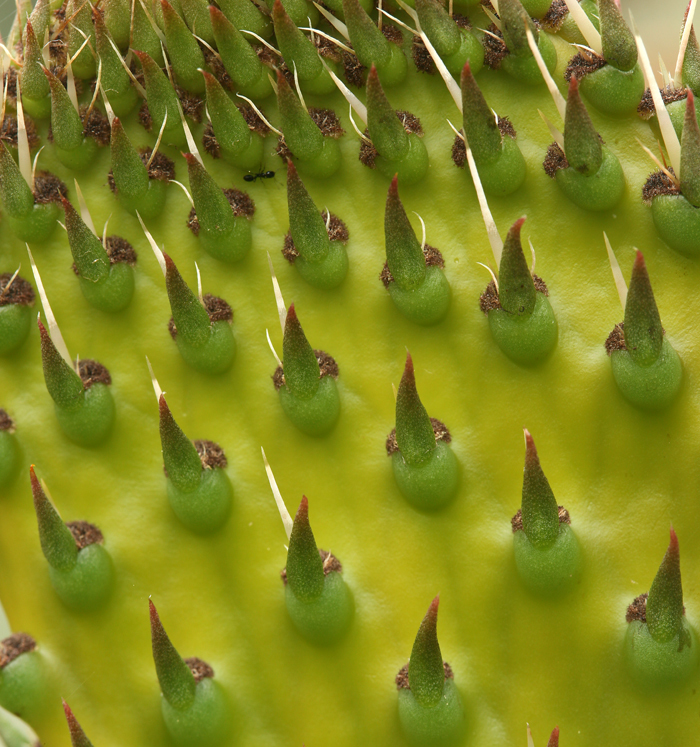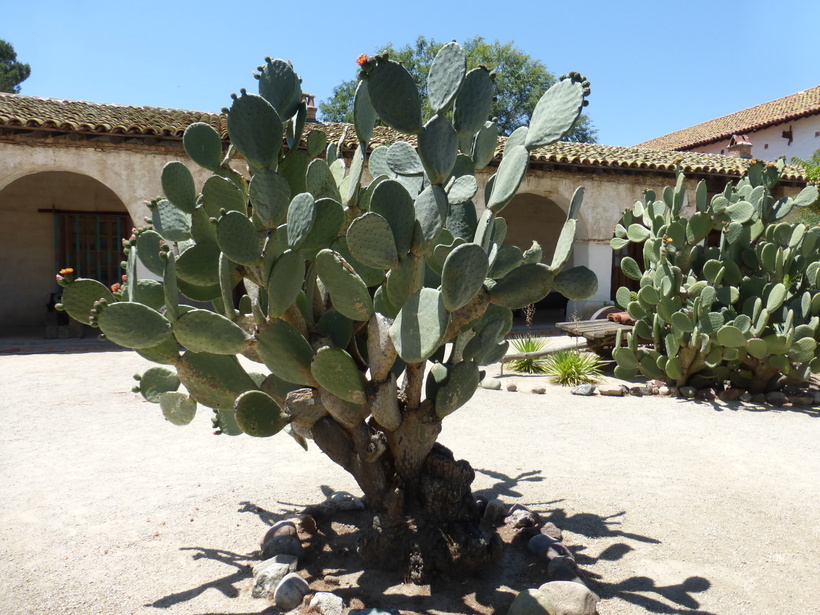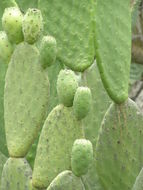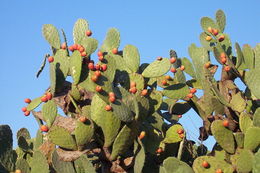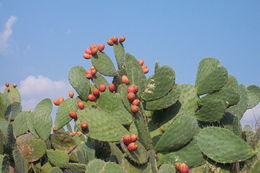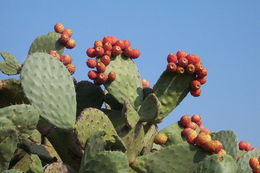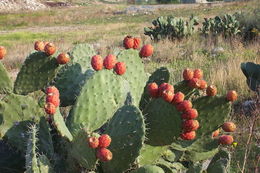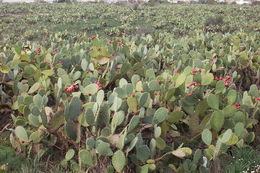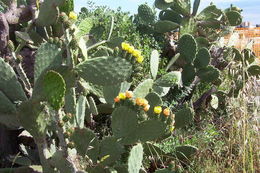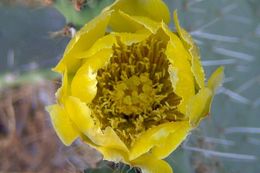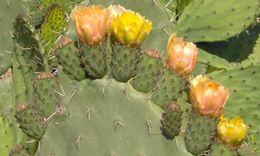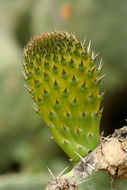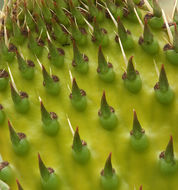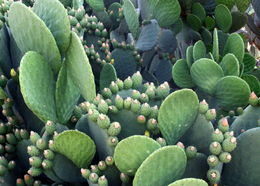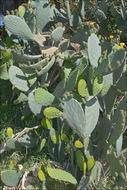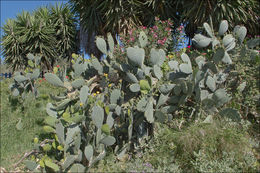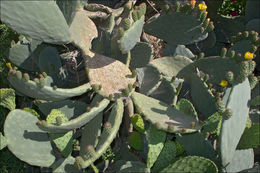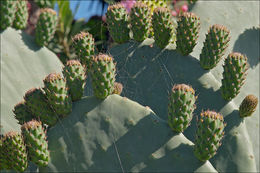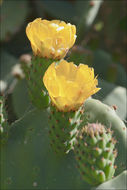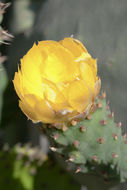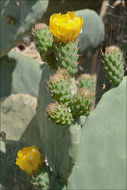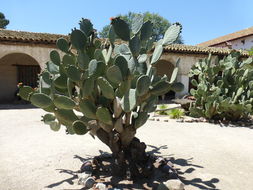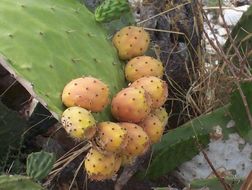-
-
the ancient edible selection with origins in central Mexico. It was subsequently spread world wide in temperate regions as a food source by the Spaniards and European traders.
-
-
-
-
-
-
-
-
-
-
-
UC-Davis Arboretum
-

Slo.: opuncija - syn.: Opuntia ficus-barbarica Berg. - Habitat: roadside; semiruderal place, border of an unmaintained garden, almost flat terrain; stony, skeletal ground, full sun, elevation 37 m (120 feet); average precipitations 900 - 1100 mm/year, average temperature about 18 deg C, Mediterranean phytogeographical region. Substratum: soil.Comment: Opuntia ficus-indica is a familiar cactus, which origins in tropical America. It is believed that it was introduced to Europe by Christopher Columbus. Today broadly spread in all Mediterranean countries and often cultivated, it is already naturalized plant in many regions. Here are there one can find it also in Slovenian submediterranean phytogeographical region, but only as a cultivar.Its fruits are edible. Surprisingly it has few and small spines. A bigger problem are its short, partly hooked and brittle bristles, which are very unpleasant when in your skin. They grow mostly in tufts from many areolas (small, well-defined areas) on their leaves. In Crete its fruits are sold and consumed as an esteemed fruit. But, how natives get rid of annoying bristles remained a secret for me.Ref.:(1) I. Schnfelder, P. Schnfelder, Kosmos Atlas Mittelmeer- und Kanarenflora, Kosmos, (2002), p 132.(2) I. Schnfelder, P. Schnfelder, Was blht am Mittelmeer? Kosmos (2000), p 98.(3) M. Blamey, C. Grey-Wilson, Wild Flowers of the Mediterranean, A & C Black, London (2005), p 149.(4) R. Domac, Flora Hrvatske (Flora of Croatia) (in Croatian), kolska Knjiga, Zagreb (1994), p 72.(5) D. Seidel, Blumen am Mittelmeer, BLV (2002), p 75.(6) V. Papiomytoglou, Wildblumen aus Griechenland, Mediterraneo Editions (2006), p 33.
-
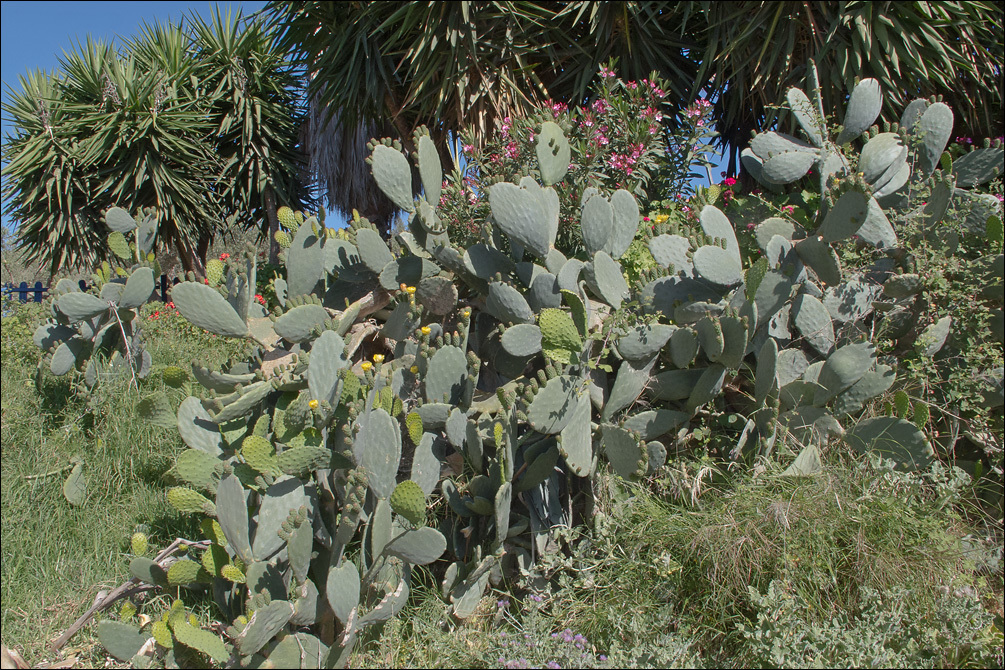
Slo.: opuncija - syn.: Opuntia ficus-barbarica Berg. - Habitat: roadside; semiruderal place, border of an unmaintained garden, almost flat terrain; stony, skeletal ground, full sun, elevation 37 m (120 feet); average precipitations 900 - 1100 mm/year, average temperature about 18 deg C, Mediterranean phytogeographical region. Substratum: soil. Comment: Opuntia ficus-indica is a familiar cactus, which origins in tropical America. It is believed that it was introduced to Europe by Christopher Columbus. Today broadly spread in all Mediterranean countries and often cultivated, it is already naturalized plant in many regions. Here are there one can find it also in Slovenian submediterranean phytogeographical region, but only as a cultivar. Its fruits are edible. Surprisingly it has few and small spines. A bigger problem are its short, partly hooked and brittle bristles, which are very unpleasant when in your skin. They grow mostly in tufts from many areolas (small, well-defined areas) on their leaves. In Crete its fruits are sold and consumed as an esteemed fruit. But, how natives get rid of annoying bristles remained a secret for me. Ref.: (1) I. Schnfelder, P. Schnfelder, Kosmos Atlas Mittelmeer- und Kanarenflora, Kosmos, (2002), p 132. (2) I. Schnfelder, P. Schnfelder, Was blht am Mittelmeer? Kosmos (2000), p 98. (3) M. Blamey, C. Grey-Wilson, Wild Flowers of the Mediterranean, A & C Black, London (2005), p 149. (4) R. Domac, Flora Hrvatske (Flora of Croatia) (in Croatian), kolska Knjiga, Zagreb (1994), p 72. (5) D. Seidel, Blumen am Mittelmeer, BLV (2002), p 75. (6) V. Papiomytoglou, Wildblumen aus Griechenland, Mediterraneo Editions (2006), p 33.
-
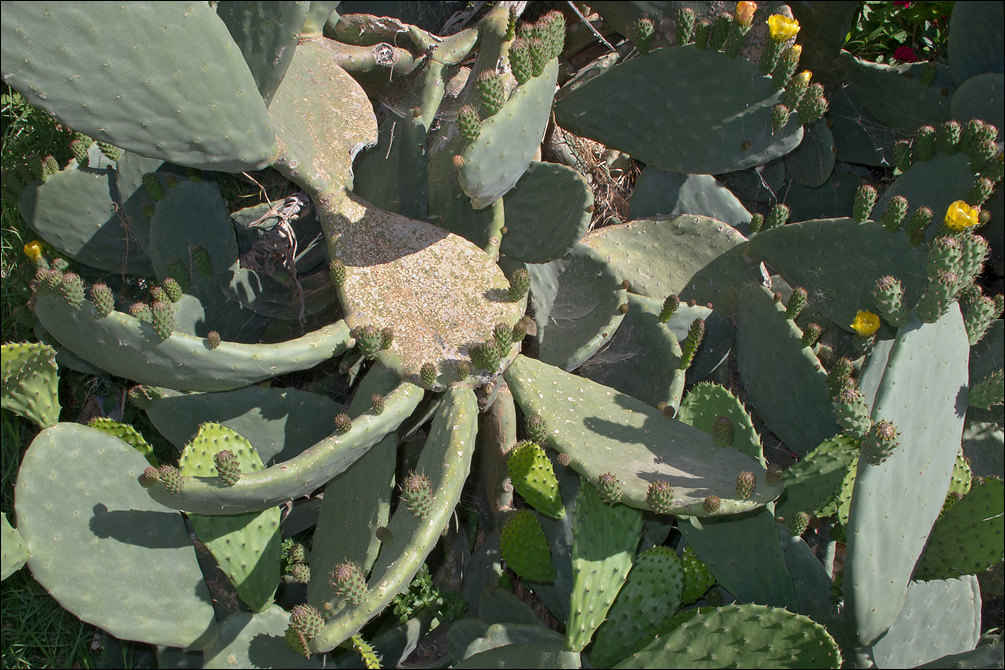
Slo.: opuncija - syn.: Opuntia ficus-barbarica Berg. - Habitat: roadside; semiruderal place, border of an unmaintained garden, almost flat terrain; stony, skeletal ground, full sun, elevation 37 m (120 feet); average precipitations 900 - 1100 mm/year, average temperature about 18 deg C, Mediterranean phytogeographical region. Substratum: soil. Comment: Opuntia ficus-indica is a familiar cactus, which origins in tropical America. It is believed that it was introduced to Europe by Christopher Columbus. Today broadly spread in all Mediterranean countries and often cultivated, it is already naturalized plant in many regions. Here are there one can find it also in Slovenian submediterranean phytogeographical region, but only as a cultivar. Its fruits are edible. Surprisingly it has few and small spines. A bigger problem are its short, partly hooked and brittle bristles, which are very unpleasant when in your skin. They grow mostly in tufts from many areolas (small, well-defined areas) on their leaves. In Crete its fruits are sold and consumed as an esteemed fruit. But, how natives get rid of annoying bristles remained a secret for me. Ref.: (1) I. Schnfelder, P. Schnfelder, Kosmos Atlas Mittelmeer- und Kanarenflora, Kosmos, (2002), p 132. (2) I. Schnfelder, P. Schnfelder, Was blht am Mittelmeer? Kosmos (2000), p 98. (3) M. Blamey, C. Grey-Wilson, Wild Flowers of the Mediterranean, A & C Black, London (2005), p 149. (4) R. Domac, Flora Hrvatske (Flora of Croatia) (in Croatian), kolska Knjiga, Zagreb (1994), p 72. (5) D. Seidel, Blumen am Mittelmeer, BLV (2002), p 75. (6) V. Papiomytoglou, Wildblumen aus Griechenland, Mediterraneo Editions (2006), p 33.
-
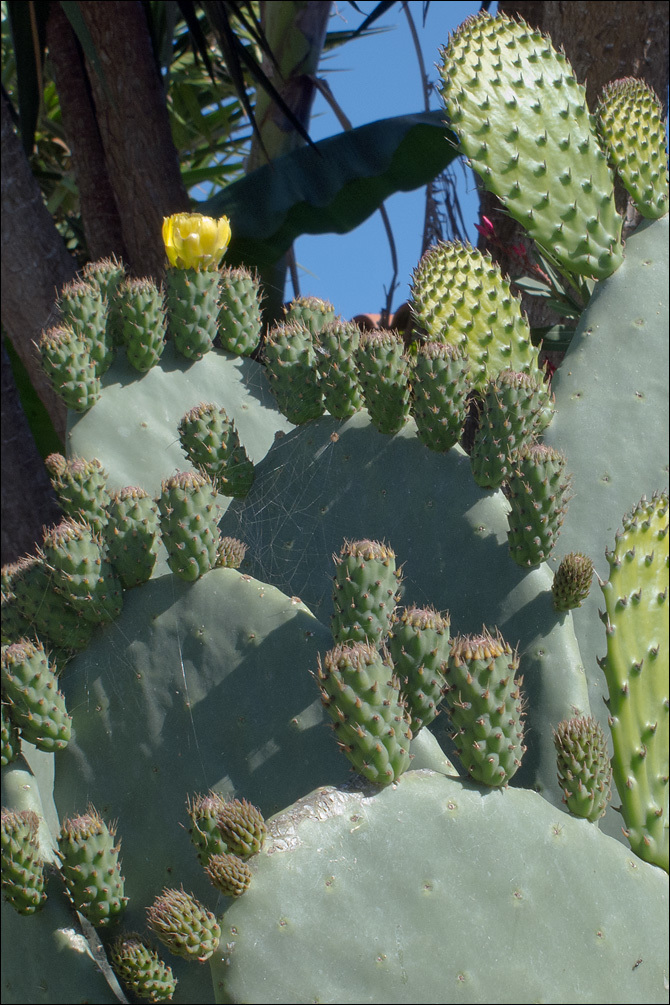
Slo.: opuncija - syn.: Opuntia ficus-barbarica Berg. - Habitat: roadside; semiruderal place, border of an unmaintained garden, almost flat terrain; stony, skeletal ground, full sun, elevation 37 m (120 feet); average precipitations 900 - 1100 mm/year, average temperature about 18 deg C, Mediterranean phytogeographical region. Substratum: soil. Comment: Opuntia ficus-indica is a familiar cactus, which origins in tropical America. It is believed that it was introduced to Europe by Christopher Columbus. Today broadly spread in all Mediterranean countries and often cultivated, it is already naturalized plant in many regions. Here are there one can find it also in Slovenian submediterranean phytogeographical region, but only as a cultivar. Its fruits are edible. Surprisingly it has few and small spines. A bigger problem are its short, partly hooked and brittle bristles, which are very unpleasant when in your skin. They grow mostly in tufts from many areolas (small, well-defined areas) on their leaves. In Crete its fruits are sold and consumed as an esteemed fruit. But, how natives get rid of annoying bristles remained a secret for me. Ref.: (1) I. Schnfelder, P. Schnfelder, Kosmos Atlas Mittelmeer- und Kanarenflora, Kosmos, (2002), p 132. (2) I. Schnfelder, P. Schnfelder, Was blht am Mittelmeer? Kosmos (2000), p 98. (3) M. Blamey, C. Grey-Wilson, Wild Flowers of the Mediterranean, A & C Black, London (2005), p 149. (4) R. Domac, Flora Hrvatske (Flora of Croatia) (in Croatian), kolska Knjiga, Zagreb (1994), p 72. (5) D. Seidel, Blumen am Mittelmeer, BLV (2002), p 75. (6) V. Papiomytoglou, Wildblumen aus Griechenland, Mediterraneo Editions (2006), p 33.
-
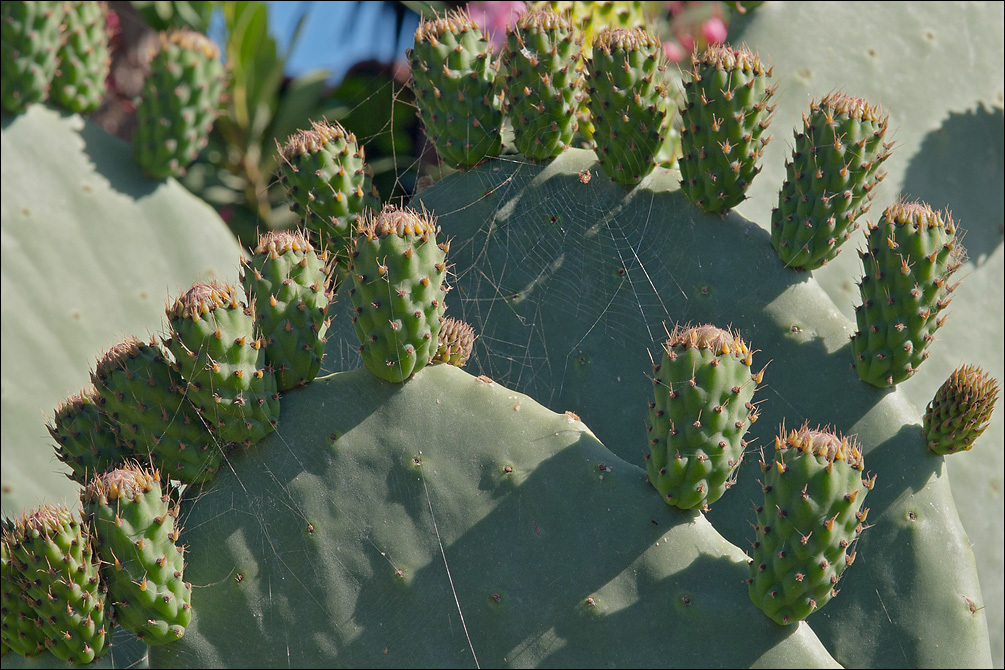
Slo.: opuncija - syn.: Opuntia ficus-barbarica Berg. - Habitat: roadside; semiruderal place, border of an unmaintained garden, almost flat terrain; stony, skeletal ground, full sun, elevation 37 m (120 feet); average precipitations 900 - 1100 mm/year, average temperature about 18 deg C, Mediterranean phytogeographical region. Substratum: soil. Comment: Opuntia ficus-indica is a familiar cactus, which origins in tropical America. It is believed that it was introduced to Europe by Christopher Columbus. Today broadly spread in all Mediterranean countries and often cultivated, it is already naturalized plant in many regions. Here are there one can find it also in Slovenian submediterranean phytogeographical region, but only as a cultivar. Its fruits are edible. Surprisingly it has few and small spines. A bigger problem are its short, partly hooked and brittle bristles, which are very unpleasant when in your skin. They grow mostly in tufts from many areolas (small, well-defined areas) on their leaves. In Crete its fruits are sold and consumed as an esteemed fruit. But, how natives get rid of annoying bristles remained a secret for me. Ref.: (1) I. Schnfelder, P. Schnfelder, Kosmos Atlas Mittelmeer- und Kanarenflora, Kosmos, (2002), p 132. (2) I. Schnfelder, P. Schnfelder, Was blht am Mittelmeer? Kosmos (2000), p 98. (3) M. Blamey, C. Grey-Wilson, Wild Flowers of the Mediterranean, A & C Black, London (2005), p 149. (4) R. Domac, Flora Hrvatske (Flora of Croatia) (in Croatian), kolska Knjiga, Zagreb (1994), p 72. (5) D. Seidel, Blumen am Mittelmeer, BLV (2002), p 75. (6) V. Papiomytoglou, Wildblumen aus Griechenland, Mediterraneo Editions (2006), p 33.
-

Slo.: opuncija - syn.: Opuntia ficus-barbarica Berg. - Habitat: roadside; semiruderal place, border of an unmaintained garden, almost flat terrain; stony, skeletal ground, full sun, elevation 37 m (120 feet); average precipitations 900 - 1100 mm/year, average temperature about 18 deg C, Mediterranean phytogeographical region. Substratum: soil. Comment: Opuntia ficus-indica is a familiar cactus, which origins in tropical America. It is believed that it was introduced to Europe by Christopher Columbus. Today broadly spread in all Mediterranean countries and often cultivated, it is already naturalized plant in many regions. Here are there one can find it also in Slovenian submediterranean phytogeographical region, but only as a cultivar. Its fruits are edible. Surprisingly it has few and small spines. A bigger problem are its short, partly hooked and brittle bristles, which are very unpleasant when in your skin. They grow mostly in tufts from many areolas (small, well-defined areas) on their leaves. In Crete its fruits are sold and consumed as an esteemed fruit. But, how natives get rid of annoying bristles remained a secret for me. Ref.: (1) I. Schnfelder, P. Schnfelder, Kosmos Atlas Mittelmeer- und Kanarenflora, Kosmos, (2002), p 132. (2) I. Schnfelder, P. Schnfelder, Was blht am Mittelmeer? Kosmos (2000), p 98. (3) M. Blamey, C. Grey-Wilson, Wild Flowers of the Mediterranean, A & C Black, London (2005), p 149. (4) R. Domac, Flora Hrvatske (Flora of Croatia) (in Croatian), kolska Knjiga, Zagreb (1994), p 72. (5) D. Seidel, Blumen am Mittelmeer, BLV (2002), p 75. (6) V. Papiomytoglou, Wildblumen aus Griechenland, Mediterraneo Editions (2006), p 33.
-
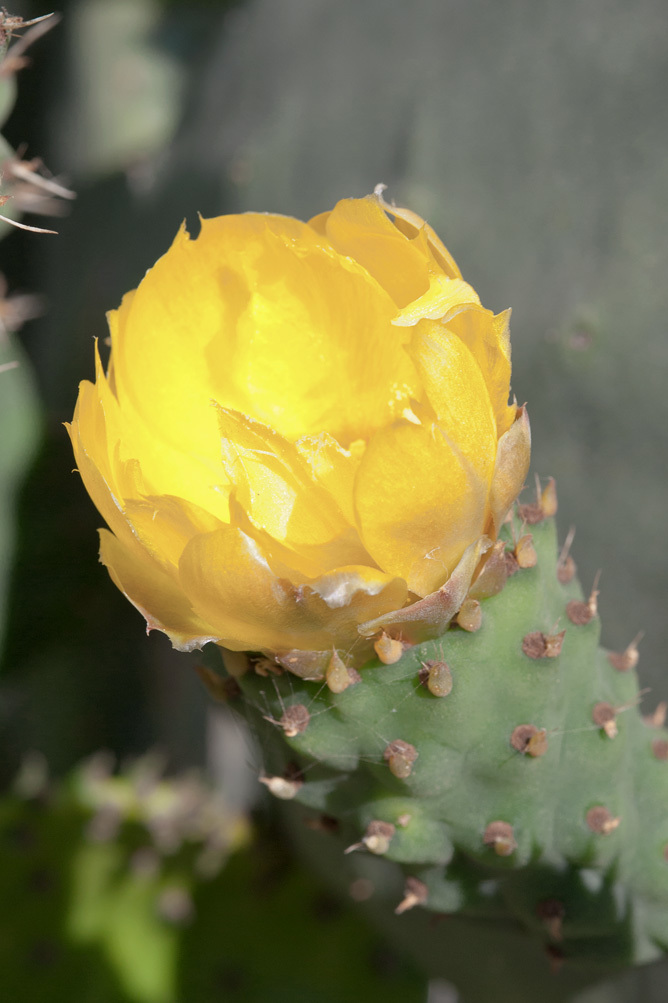
Slo.: opuncija - syn.: Opuntia ficus-barbarica Berg. - Habitat: roadside; semiruderal place, border of an unmaintained garden, almost flat terrain; stony, skeletal ground, full sun, elevation 37 m (120 feet); average precipitations 900 - 1100 mm/year, average temperature about 18 deg C, Mediterranean phytogeographical region. Substratum: soil. Comment: Opuntia ficus-indica is a familiar cactus, which origins in tropical America. It is believed that it was introduced to Europe by Christopher Columbus. Today broadly spread in all Mediterranean countries and often cultivated, it is already naturalized plant in many regions. Here are there one can find it also in Slovenian submediterranean phytogeographical region, but only as a cultivar. Its fruits are edible. Surprisingly it has few and small spines. A bigger problem are its short, partly hooked and brittle bristles, which are very unpleasant when in your skin. They grow mostly in tufts from many areolas (small, well-defined areas) on their leaves. In Crete its fruits are sold and consumed as an esteemed fruit. But, how natives get rid of annoying bristles remained a secret for me. Ref.: (1) I. Schnfelder, P. Schnfelder, Kosmos Atlas Mittelmeer- und Kanarenflora, Kosmos, (2002), p 132. (2) I. Schnfelder, P. Schnfelder, Was blht am Mittelmeer? Kosmos (2000), p 98. (3) M. Blamey, C. Grey-Wilson, Wild Flowers of the Mediterranean, A & C Black, London (2005), p 149. (4) R. Domac, Flora Hrvatske (Flora of Croatia) (in Croatian), kolska Knjiga, Zagreb (1994), p 72. (5) D. Seidel, Blumen am Mittelmeer, BLV (2002), p 75. (6) V. Papiomytoglou, Wildblumen aus Griechenland, Mediterraneo Editions (2006), p 33.
-
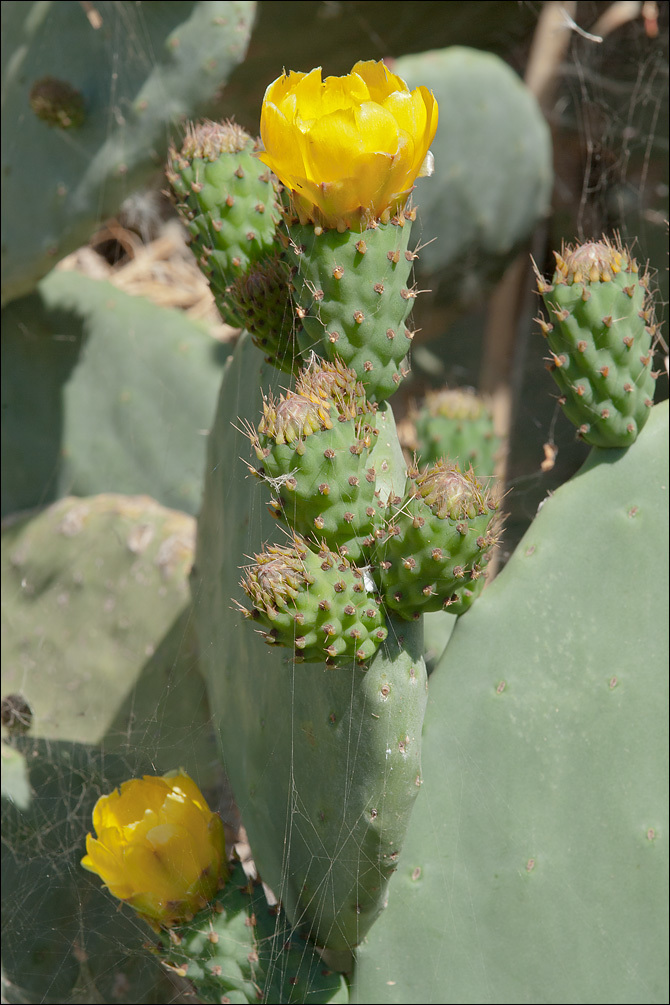
Slo.: opuncija - syn.: Opuntia ficus-barbarica Berg. - Habitat: roadside; semiruderal place, border of an unmaintained garden, almost flat terrain; stony, skeletal ground, full sun, elevation 37 m (120 feet); average precipitations 900 - 1100 mm/year, average temperature about 18 deg C, Mediterranean phytogeographical region. Substratum: soil. Comment: Opuntia ficus-indica is a familiar cactus, which origins in tropical America. It is believed that it was introduced to Europe by Christopher Columbus. Today broadly spread in all Mediterranean countries and often cultivated, it is already naturalized plant in many regions. Here are there one can find it also in Slovenian submediterranean phytogeographical region, but only as a cultivar. Its fruits are edible. Surprisingly it has few and small spines. A bigger problem are its short, partly hooked and brittle bristles, which are very unpleasant when in your skin. They grow mostly in tufts from many areolas (small, well-defined areas) on their leaves. In Crete its fruits are sold and consumed as an esteemed fruit. But, how natives get rid of annoying bristles remained a secret for me. Ref.: (1) I. Schnfelder, P. Schnfelder, Kosmos Atlas Mittelmeer- und Kanarenflora, Kosmos, (2002), p 132. (2) I. Schnfelder, P. Schnfelder, Was blht am Mittelmeer? Kosmos (2000), p 98. (3) M. Blamey, C. Grey-Wilson, Wild Flowers of the Mediterranean, A & C Black, London (2005), p 149. (4) R. Domac, Flora Hrvatske (Flora of Croatia) (in Croatian), kolska Knjiga, Zagreb (1994), p 72. (5) D. Seidel, Blumen am Mittelmeer, BLV (2002), p 75. (6) V. Papiomytoglou, Wildblumen aus Griechenland, Mediterraneo Editions (2006), p 33.
-
-
-

